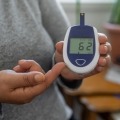Bullying, Stigma, and Diabetes at School
By April Hopcroft
 A new study suggests that dealing with diabetes at school may be more difficult than previously thought, especially when children face stigma, bullying, and negativity from students and staff. Find out how to recognize the signs of bullying, the role of diabetes devices, and how you can take action.
A new study suggests that dealing with diabetes at school may be more difficult than previously thought, especially when children face stigma, bullying, and negativity from students and staff. Find out how to recognize the signs of bullying, the role of diabetes devices, and how you can take action.
While managing blood sugar is a difficult part of diabetes care for children, new research suggests that dealing with diabetes at school may pose a significant additional challenge.
People with diabetes of all ages may experience diabetes stigma, or experiences of exclusion, rejection, prejudice, and blame as a result of their condition.
Beyond stigma, youth and teens are also vulnerable to bullying at school or in other group settings. Indeed, some research shows that teens with chronic health conditions are more likely to experience bullying compared to their peers.
Toni Armstrong, the mother of a seven-year-old with type 1 diabetes, said that her daughter Evelyn experienced bullying related to her diabetes devices during the first few months of kindergarten.
“We made a big emphasis not to pull on her devices… But one boy kept flicking her Dexcom all day and he told her it was ‘really ugly,’ which was a big problem,” said Armstrong.
What is bullying and how does it affect mental health?
Bullying refers to unwanted aggressive behavior that is intended to hurt someone physically or emotionally – either in person or online. Bullying can include:
-
Physical contact
-
Harmful words
-
Threats
-
Humiliation
Bullying can lead to a range of negative health outcomes, such as anxiety, depression, self-harm or suicidal thoughts, trouble sleeping, and low self-confidence.
Diabetes stigma and bullying can also affect diabetes care behavior. People with diabetes who are bullied may have worse self-management and a higher A1C. Likewise, research from diabetes marketing research firm dQ&A shows that some people with diabetes may be hesitant to use diabetes technology due to stigma.
Three key challenges of diabetes at school
Youth with type 1 diabetes may experience more bullying than those without diabetes. Beyond bullying, a new study identified several challenges of diabetes management at school by speaking to a small group of students with type 1 diabetes. The researchers noted three main themes:
1. Limits on using diabetes technology during classes are hard to navigate
Often, diabetes management and school rules can be in direct conflict with each other. This poses a dilemma for children with diabetes – take care of their diabetes and risk disrupting their learning, or follow the school rules and neglect their diabetes care.
2. Diabetes stigma can be present in the classroom
Sensor alerts and even routine diabetes care (such as taking insulin) can draw attention to people with diabetes and away from learning. Some students said they were criticized for using their phones in class to manage their blood glucose or disrupting class when their alarms went off.
3. Navigating parent or caregiver involvement in care poses an additional challenge
Thanks to advances in technology, it is possible for parents and caregivers to see their child’s glucose via remote monitoring. Some students said that intervention from their parents during the school day complicated their diabetes care and made stigma worse.
Dr. Sarah Westen, a diabetes psychologist at the University of Florida, said that parent involvement can be especially challenging for teens to navigate.
“With my teenage patients in the therapy setting, that can feel like nagging sometimes,” Westen said. “This can lead to feeling like they’re not independent in their management, which can lead to family conflict and more distress in the school setting, and can end up leading to conflict with peers. It can escalate the distress that’s around navigating diabetes.”
Bullying and obesity
While there is little research on bullying among children with type 2 diabetes, these students may also experience stigma, diabetes distress, and bullying. In particular, children and teens with overweight or obesity are more likely to encounter bullying compared to their normal weight peers.
Weight bias can negatively impact mental and physical health, and even make obesity worse. To address weight bias, the Obesity Action Coalition (OAC) recommends awareness and education, recognizing weight bias, and responding to weight stigma using OAC’s resources and tools.
How do diabetes devices affect stigma and bullying?
While diabetes can be considered an “invisible” disability, it can also be highly visible. Westen said that children with diabetes may feel different because of their diabetes devices and supplies. At best, diabetes devices can invite curiosity and questions. At worst, diabetes technology can cause shame or taunting, leading to stigma, resentment, and even jealousy from peers.
One of the best ways to combat bullying is to educate peers on diabetes technology.
For example, Toni and Evelyn brainstormed with her nurse and kindergarten teacher and decided to host a “diabetes day” to educate Evelyn’s class. Students watched videos on diabetes basics, examined an unused pump and old transmitter, and learned how diabetes care works through Evelyn’s stuffed animal DiaBetty.
How can you address bullying and diabetes at school?
Westen recommends planning ahead so that children are prepared for questions or situations that may arise at school.
“A lot of bullying happens when there’s a catastrophe or an embarrassing moment that children can’t navigate,” Westen said.
Throughout the planning process, it’s important to include the child’s voice and make sure their preferences are respected. Every child is different – some children may not want others to know they have diabetes, while others may enjoy explaining their condition and self-advocating at school.
“There’s no one right answer. The key is talking to your child, making plans with your healthcare provider, other parents, and the school staff so that everyone is on the same page,” Westen said.
Meet with your child’s teacher at the start of the school year
It’s a good idea for you and your child to meet with your child’s teacher and/or school nurse. During this meeting, you can discuss your child’s preferences regarding their diabetes care and how comfortable they are talking about diabetes.
This can also be a good time to review your child’s Diabetes Medical Management Plan (DMMP) and/or 504 plan, if you choose to create one. These plans involve some preparation, but your child’s diabetes care team should be able to help with the paperwork.
Have a consistent morning routine
Another part of planning ahead involves having a consistent morning routine to reduce surprises before getting to school.
“Behaviors respond best to patterns of consistency over time,” Westen said. “Having a consistent morning routine sets the child up to feel more empowered and resilient in the school setting, so they can react better [to stigma or bullying].”
Carry a “cheat sheet” at school
Westen also suggested having a “cheat sheet” with basic information about diabetes. This can be especially helpful if for a substitute teacher, parent chaperone, or new staff member.
Consider including the following information:
-
What diabetes is and what type of diabetes your child has
-
Why your child carries diabetes devices and a smartphone
-
Information regarding alarms that may go off and what they mean
-
What to do in case of hypoglycemia and diabetic ketoacidosis (DKA)
Educate, educate, educate to normalize diabetes
One of the most important parts of addressing stigma and bullying is normalizing diabetes. For young children, it may be helpful for parents or caregivers to give a short presentation on diabetes during the first week of class.
Older children may feel more comfortable presenting on their own and describing how they take care of their diabetes. It’s a good idea for the teacher and school administration to also take part in normalizing diabetes in the classroom and other school settings.
In addition to educating students, Armstrong said it’s important that school staff be educated on diabetes. In her case, she included a note in Evelyn’s 504 plan that all staff must be trained in diabetes, since teachers often rotate between classes at her charter school.
If you have access to a psychologist, they can also help discuss ways to promote childhood normalcy with diabetes. Armstrong said that her family psychologist encouraged the family to learn how to use different insulins so that Evelyn could participate in activities with her class, such as eating birthday cake or walking to a park for recess.
Educating others about diabetes is important, but it can also be hard work. Armstrong said that she had to take a lot of initiative to ensure students and staff were educated on diabetes in order to support her daughter’s mental health.
“The educational rights of students with disabilities – the right to the same education as their peers, the right to learn alongside their peers, and the right to a least restrictive learning environment – also supports a student’s mental health. When their educational rights aren’t honored, it also negatively impacts their mental health."
Seek out communities for people with diabetes
Joining a group of fellow people with diabetes can also give you the tools you need to address bullying. Here are some good resources to start with:
-
Reach out to your local JDRF chapter to see if there are support groups or upcoming events.
-
The ADA’s Safe at School campaign helps ensure the diabetes management needs of children are met at school.
-
For students starting college, The Diabetes Link provides a supportive community of people with diabetes, as well as social events and other resources.







